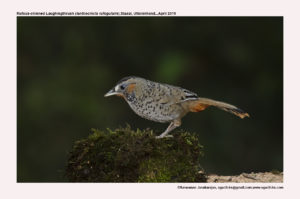Rufous-chinned Laughingthrush

Rufous-chinned Laughingthrush Garrulaxru fogularis
Etymology:
- Garrulax : Latin word garrulous –babbling, chattering; ax – inclining towards
- Rufogularis : Latin word rufusred; gularis –throated { Red throated}
Vernacular Names: Lepcha: Narbigivan-pho, Naga: Mi-pa-pita
Distribution in India: Resident in Himalayas and North East India.
Description: Size of 20-22 cm; wt. of 58-73 g.It is a fairly large, dark-faced laughingthrush, olive-brown with black scales above, greyish-white with black spots below, with rufous chin and tail tips. The nominate race has black crown, postocular supercilium, neck side, nape and upperparts warm ochraceous to rufescent olive-brown with black tips, warmer on uppertail-coverts, tail warm mid-brown with brown-tinged blackish subterminal band and broad chestnut tips. The greater and median upperwing-coverts are broadly tipped black, primary coverts are blackish, tertials and secondaries are as upperparts with broad subterminal black and narrow terminal white tips. The primaries are fringed pale grey; loral area buff , area around eye sooty grey, narrow postocular eyestripe black, ear-coverts blackish-rufous, cheek and broad submoustachial area to behind lower ear-coverts blackish with sparse buff flecks and breaking up into black spots down breast side. The chin is variably rufous, this colour sometimes extending to upper throat, throat usually whitish, breast and mid-belly pale greyish, variably tinged buffy brown, mid-belly often paler, flanks greyish to warm mid-brown, breast, upper belly and flanks tipped with variably shaped black marks, vent rufous-chestnut. The iris is dark crimson-brown to purple-red, large orbital ring grey; bill horn-brown, paler on lower mandible; legs greyish-horn to pale horn. Both the sexes are similar. The juvenile has reduced dark markings, particularly on crown and upperparts, with rufous edgings on secondaries and tertials, and more extensive rufous wash below; subadult female lacks full black cap and more rufescent below. Race rufitinctus (Meghalaya)has fringes of wingpanel more buffy grey, ear-coverts are paler rufous, whole throat and lores are pale rufous, submoustachial black is reduced and mixed with throat colour, underparts are darker and more washed warm buff, black spots are reduced; race rufiberbis ( South East Arunachal Pradesh) is more uniform grey, rufous of chin is pale but restricted, upperparts are brighter, larger black scaling; assamensis(NE Indian hill states South of Brahmaputra except Meghalaya)has chin and part of ear-coverts as pale rust, black on throat side is more extensive, upperparts are generally more saturated;.
Habitat: It is found in dense undergrowth in broadleaf evergreen forest, forest edge, secondary growth, scruband dense thickets; favours forest edge and regrowth on abandoned fields.It is found at 610 to 2200 m.
Food habits : It eats Insects, including wasps, also berries and seeds. It is found in pairs or in small parties. It forages mostly on ground and among low bushes.
Breeding habits: They breed in Apr–Sept in India and Bhutan and is multi-brooded. The nest is reportedly a fairly deep cup, made of creeper tendrils, twigs, roots, scraps of bracken, sometimes dead leaves and grasses, lined with rootlets, fine black lichen fibers, black moss roots and scraps of dead leaves, above ground, usually in fork, in bush or tree. They lay a clutch of 2–4 eggs. The incubationis done by both sexes. The nestling period is10-12 days. Brood parasitism done by Chestnut-winged Cuckoo and Large Hawk-cuckoo.